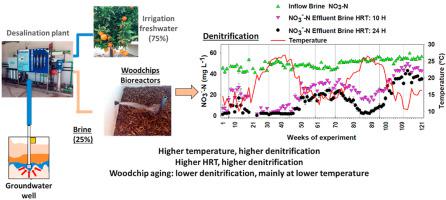Journal of Environmental Management ( IF 8.7 ) Pub Date : 2021-04-08 , DOI: 10.1016/j.jenvman.2021.112521 Carolina Díaz-García , Juan J. Martínez-Sánchez , Bryan M. Maxwell , José Antonio Franco , José Álvarez-Rogel

|
Woodchip bioreactors are widely known as a best management practice to reduce excess nitrate loads that are discharged with agricultural leachates. The aim of this study was to evaluate the performance of citrus woodchip bioreactors for denitrification of brine (electrical conductivity ≈ 17 mS cm−1) from groundwater desalination plants with high nitrate content (NO3−-N ≈ 48 mg L−1) in the Campo de Cartagena agricultural watershed, one of the main providers of horticultural products in Europe. The performance was evaluated relative to seasonal changes in temperature, dissolved organic carbon (DOC) provided by woodchips, hydraulic residence time (HRT) and woodchip aging. Bioreactors (capacity 1 m3) operated for 2.5 years (121 weeks) in batch mode (24 h HRT) with three batches per week. Denitrification efficiency was modulated by DOC concentration, temperature, hydraulic residence time and the drying-rewetting cycles. High salinity of brine did not prevent nitrate removal from occurring. The high DOC availability (>25 mg C L−1) during the first ≈48 weeks resulted in high nitrate removal rate (>75%) and nitrate removal efficiency (until ≈ 25 g N m−3 d−1) regardless of temperature. Moreover, the high DOC contents in the effluents during this period may present environmental drawbacks. Denitrification was still high after 2.5 years (reaching ≈9.3 g N m−3 d−1 in week 121), but dependence on warm temperature became more apparent with woodchips aging from week ≈49 onwards. Nitrate removal efficiency was highest on the first weekly batch, immediately after woodchips had been unsaturated for four days. It was attributable to a flush of DOC produced by aerobic microbial metabolism during drying that stimulated denitrification following re-saturation. Hence, alternance of drying-rewetting cycles is an operation practice that increase bioreactors nitrate removal performance.
中文翻译:

木片生物反应器可对地下水淡化厂的盐水进行持续反硝化
木片生物反应器被广泛认为是减少农业渗滤液排放的过量硝酸盐负荷的最佳管理方法。这项研究的目的是评估柑桔木片生物反应器对硝酸盐含量高(NO 3 -- N≈48 mg L -1)的地下水淡化厂中的盐水(电导率≈17 mS cm -1)进行反硝化的性能。Campo de Cartagena农业集水区,是欧洲园艺产品的主要提供者之一。相对于温度,木屑提供的溶解有机碳(DOC),水力停留时间(HRT)和木屑老化的季节性变化来评估性能。生物反应器(容量1 m 3)以批次方式(HRT 24小时)运作2.5年(121周),每周进行三批次。反硝化效率受DOC浓度,温度,水力停留时间和干湿循环的影响。盐水的高盐度不能阻止硝酸盐的去除。在最初的≈48周内,DOC的高利用率(> 25 mg CL -1)导致较高的硝酸盐去除率(> 75%)和硝酸盐去除效率(直到≈25 g N m -3 d -1),而与温度无关。此外,在此期间废水中的高DOC含量可能会带来环境方面的不利影响。2.5年后反硝化作用仍然很高(达到≈9.3 g N m -3 d -1在第121周),但是随着木片从第49周开始老化,对温暖温度的依赖性变得更加明显。在木片不饱和四天后,第一周的硝酸盐去除效率最高。这归因于干燥过程中有氧微生物代谢产生的DOC泛红,这刺激了再饱和后的反硝化作用。因此,干燥-再湿循环的交替是增加生物反应器硝酸盐去除性能的操作实践。

























 京公网安备 11010802027423号
京公网安备 11010802027423号